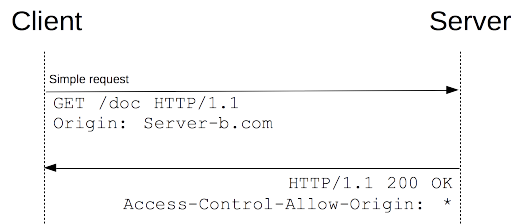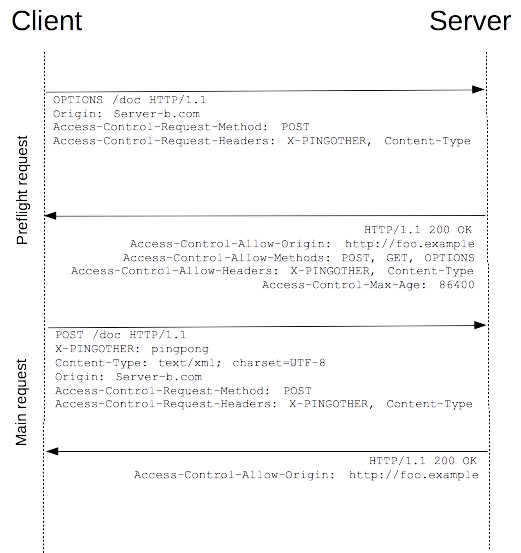Asynchronous JavaScript and XML
1. XMLHttpRequest
前端开发都知道,不多说。
var xhr = new XMLHttpRequest();
xhr.onreadystatechange = function () {
if (xhr.readyState !== 4) return;
if (xhr.status >= 200 && xhr.status < 300) {
console.log(JSON.parse(xhr.responseText));
}
else {
// What to do when the request has failed
console.log('error', xhr);
}
};
xhr.open('GET', 'https://mysite.com/index');
xhr.setRequestHeader('X-Token', '123456');
xhr.send();
1.1 open方法
定义:open( Method, URL, Asynchronous, UserName, Password )
- Method:GET/POST/HEAD/PUT/DELETE/OPTIONS
- Asynchronous(defualt true)
1.2 setRequestHeader方法
定义:setRequestHeader( Name, Value )
注意,以X开头的为header为自定义头部
1.3 send方法
定义:send(body)
- body可以是:document,Blob, BufferSource, FormData, URLSearchParams, ReadableStream等
2. Fetch
新一代旨在替换XHR的API方法。
fetch("https://mysite.com/index", {
method: "POST",
headers: {
"Content-Type": "application/x-www-form-urlencoded",
'X-Token': '123456'
},
body: "id=123"
}).then(function (response) {
if (response.ok) {
return response.json();
} else {
return Promise.reject({
status: response.status,
statusText: response.statusText
});
}
})
.then(function (data) {
console.log('success', data);
})
.catch(function (error) {
console.log('error', error);
});
2.1 fetch方法
定义:fetch(input, init)
- input:URL或者Request对象
- init:一个配置项对象,包括所有对请求的设置。可选的参数有:
- method: 请求使用的方法,如 GET、POST。
- headers: 请求的头信息,形式为 Headers 对象或 ByteString。
- body: 请求的 body 信息:可能是一个 Blob、BufferSource、FormData、URLSearchParams 或者 USVString 对象。注意 GET 或 HEAD 方法的请求不能包含 body 信息。
- mode: 请求的模式,如 cors、 no-cors 或者 same-origin。
- credentials: 请求的 credentials,如 omit、same-origin 或者 include。
- cache: 请求的 cache 模式: default, no-store, reload, no-cache, force-cache, or only-if-cached.
2.2 回调
fetch返回一个promise,采用then的链式调用避免回调地狱问题。
2.3 返回值
参考这里:https://developer.mozilla.org/zh-CN/docs/Web/API/Response
3. XHR vs Fetch
- Fetch返回值不是可读的形式,需要使用response.json()转换为可读形式
- XHR的请求失败通过判断状态码,Fetch请求失败通过catch处理
- Fetch默认不带cookie,XHR默认带cookie
- Fetch在服务器返回 400,500 错误码时并不会reject而被当做成功处理进then,只有网络错误这些导致请求不能完成才会触发catch
- Fetch没有abort和onTimeout,不能中途中断,XHR可以。
Cross-Origin Resource Sharing
CORS是一种机制,用来保护跨域数据传输的安全性和降低风险。
1. 常见的可以跨域请求的资源
- XHR或Fetch发起的跨域HTTP请求
- Web字体
- CSS文件
- Scripts文件
2. 跨域相关的Http首部
-
Access-Control-Request-Headers
(Preflight使用)客户端告诉服务器实际请求时使用的头部。 -
Access-Control-Request-Method
(Preflight使用)客户端告诉服务器实际请求时使用的方法。 -
Access-Control-Allow-Origin
服务端允许请求的源域 -
Access-Control-Allow-Credentials
服务端是否允许请求带cookie,设置为true时allow-origin不能为* -
Access-Control-Allow-Headers
服务端允许的客户端请求的头部 -
Access-Control-Allow-Methods
服务端允许客户端请求的方法 -
Access-Control-Max-Age
preflight可以被缓存的时间 -
Cross-Origin-Resource-Policy
(fetch使用)具体查看https://fetch.spec.whatwg.org/#cross-origin-resource-policy-header -
Origin
客户端请求从哪个域来
1. OPTIONS /resources/post-here/
2. HTTP/1.1
3. Host: bar.other
4. User-Agent: Mozilla/5.0 (Macintosh; U; 5.Intel Mac OS X 10.5; en-US; rv:1.9.1b3pre) Gecko/20081130 Minefield/3.1b3pre
6. Accept: text/html,application/xhtml+xml,application/xml;q=0.9,*/*;q=0.8
7. Accept-Language: en-us,en;q=0.5
8. Accept-Encoding: gzip,deflate
9. Accept-Charset: ISO-8859-1,utf-8;q=0.7,*;q=0.7
10. Connection: keep-alive
11. Origin: http://foo.example
12. Access-Control-Request-Method: POST
13. Access-Control-Request-Headers: X-PINGOTHER, Content-Type
//响应
14. HTTP/1.1 200 OK
15. Date: Mon, 01 Dec 2008 01:15:39 GMT
16. Server: Apache/2.0.61 (Unix)
17. Access-Control-Allow-Origin: http://foo.example
18. Access-Control-Allow-Methods: POST, GET, OPTIONS
19. Access-Control-Allow-Headers: X-PINGOTHER, Content-Type
20. Access-Control-Max-Age: 86400
21. Vary: Accept-Encoding, Origin
22. Content-Encoding: gzip
23. Content-Length: 0
24. Keep-Alive: timeout=2, max=100
25. Connection: Keep-Alive
26. Content-Type: text/plain
3. 简单请求
跨域请求分为简单请求和预检请求,全部符合下列条件时为简单请求:
- 使用的方法为:GET/HEAD/POST
- 不得设置安全首页之外的首页:Accept,Accept-Language,Content-Language,Content-Type,DPR,Downlink,Save-Data,Viewport-Width,Width
- Content-Type只能是以下值: text/plain, multipart/form-data, application/x-www-form-urlencoded
- 请求中的任意XMLHttpRequestUpload 对象均没有注册任何事件监听器
- 请求中没有使用 ReadableStream 对象
当使用普通请求时,如果服务器允许该源域跨域请求资源,则直接返回响应。如果服务器不允许跨域请求,则返回不正确的响应首部,则请求方不会收到任何数据。

4. 预检请求(preflight request)
除了简单请求的情况,其他的CORS请求都会有预检请求。
预检请求会先使用OPTIONS方法发起一个预检请求到服务器,以获知服务器是否允许该实际请求,所以会进行2个回合的通信。
典型的会触发预检请求的跨域情景:请求JSON数据 或 带有自定义头部
如:
- content-type:application/json
- X-Audit-Token:X123456

JSONP
跨域请求的一种常见实现方式.
1. 优缺点
- 优点:
不受同源策略限制,可以向没有启用CORS的跨域服务端请求数据。
兼容性较强,所有浏览器都支持该技术。 - 缺点
只支持GET,不支持POST
请求失败时不会有HTTP状态码返回
安全性也是一个值得考虑的问题
2. 实现原理
- Client端用JS动态生成一个script标签并添加到文档流中,如
<script type="text/javascript">
function jsonpCallBack(data){
console.log(data.msg);
}
$(document).ready(function(){
$("body").append('<script src="http://www.ASite.com/ServerJSONP.js?callback=jsonpCallBack"></script>');
});
</script>
- 浏览器会使用GET方法请求ASite上的ServerJSONP.js并携带参数
- 服务端接收到该请求,并根据参数中的回调函数名动态生成返回的内容,如
jsonpCallBack({msg:"this is jsonp request!"});
- 浏览器获取到script标签请求的内容后会执行其中的代码
- 最终我们定义的jsonpCallBack函数会被调用,输出: "this is jsonp request!"
refs:
https://xhr.spec.whatwg.org/
https://developer.mozilla.org/en-US/docs/Web/API/XMLHttpRequest
https://gomakethings.com/why-i-still-use-xhr-instead-of-the-fetch-api/
https://hacks.mozilla.org/2015/03/this-api-is-so-fetching/
https://developer.mozilla.org/zh-CN/docs/Web/HTTP/Access_control_CORS




